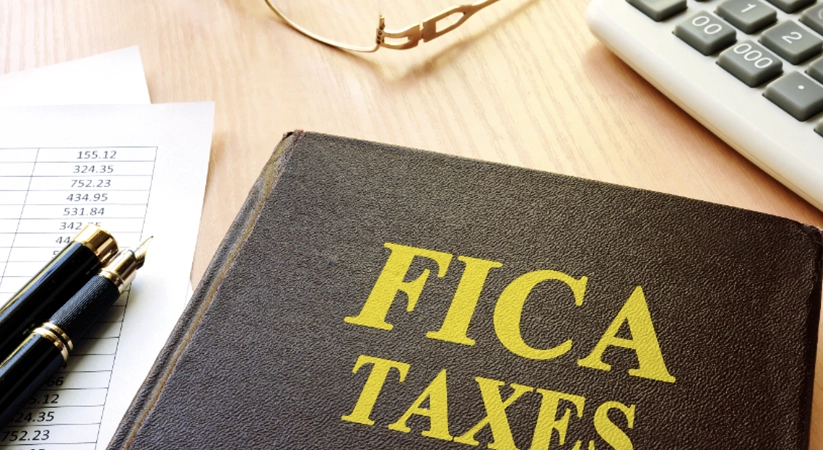
What the FICA? If I earn $160,201, I don’t have to pay into Social Security?
FICA or the Federal Insurance Contributions Act requires both employees and employers to contribute to retirement funds that support veterans, elderly, and children. FICA comprises two types of taxes: Social Security and Medicare. Both employers and employees contribute to FICA taxes with the current tax rate set at 7.65% for employees and the same rate for employers: 7.65%. This means that a total of 15.3% of an employee’s wages goes towards FICA taxes.
As of 2023, the wage cap for FICA is $160,200. Any income above this limit will not be subject to the FICA rate (Social Security only.) Meanwhile, there is no wage cap for Medicare taxes, and all income is subject to a 1.45% tax rate.
Exemptions to FICA tax on wages can vary.
For example, self-employed workers pay both the employee and employer portion of FICA taxes. Wage earners who make less than $400 a year are also exempt from FICA taxes. Meanwhile, workers who pay into FICA taxes are entitled to earned benefits from the Social Security Administration. Social Security benefits vary based on an individual’s earned income history and can include monthly retirement benefits and disability benefits.
FICA and Social Security Are Not Exactly the Same
No. While Social Security and FICA (Federal Insurance Contributions Act) are often used interchangeably, they are not the same thing. Social Security is a government program that provides retirement, disability, and survivor benefits to eligible individuals. FICA, on the other hand, is a two-part tax system that funds both Social Security and Medicare. In short, FICA includes Social Security.
The Social Security portion of FICA taxes is based on an employee’s taxable earnings. Plus, any 2023 earnings above $160,200 don’t get taxed for Social Security. The tax rate for Social Security is 6.2% for both the employer and employee, totaling 12.4% when combined.
The Medicare portion of FICA taxes is a 1.45% tax rate on all taxable income, with no wage cap. Employers also pay an additional 1.45% tax rate for Medicare, bringing the total Medicare tax rate to 2.9%.
Payroll taxes for both Social Security and Medicare are calculated by deducting the appropriate tax rate from an employee’s taxable earnings. While often seen as a burden, FICA taxes are an investment in an employee’s future retirement and healthcare benefits.
What Is the FICA Tax Rate for 2023 tax year?
The FICA tax rate for the 2023 tax year remains at 7.65%, which is a combination of the Social Security tax rate of 6.2% and the Medicare tax rate of 1.45%.
However, there is a wage base limit for the Social Security tax, meaning that any income above that limit is not subject to the tax. In 2023, the wage base limit for Social Security is $160,200 while the Medicare tax is applied to all taxable income without any limit. For employers, they must also pay a matching FICA tax rate of 7.65% on their employees’ income, with some exceptions for specific types of workers. Understanding the FICA tax rate is essential for both employees and employers to avoid any tax issues.
The Rate and Limit on Earnings
FICA taxes for employees and employers remains at 6.2%. The wage base limit for earnings in 2023 is $160,200.
Self-employed individuals pay the combined employer-employee total of 12.4% on their net earnings.
The Medicare tax rate also remains the same at 1.45% for employees and employers, with no limits on covered wages. However, wages exceeding $200,000 for individuals or $250,000 for married taxpayers filing jointly will be subject to an additional Medicare tax of 0.9%. The FICA tax withholding rate for employees remains at 7.65% for both years.
As the Social Security Administration and Medicare programs’ funding make one of the biggest costs on a wage earner’s taxable wage base, it is always essential for taxpayers, employers, and the government to be aware of the changes in FICA tax rates and limits.
When You Must Pay FICA
FICA taxes fund retirement, disability and survivor benefits, as well as health insurance for elderly Americans. The FICA tax rate for Social Security is 12.4%, which is equally split between employers and employees, with the maximum taxable earnings for Social Security set at $142,800 in 2021. For Medicare, the combined tax rate is 2.9% with no income cap.
While self-employed individuals are responsible for the full payroll tax rate of 12.4% Social Security tax and 2.9% Medicare tax, the IRS allows for a deduction of half of these taxes on their tax return. It is important for individuals to understand their FICA tax obligations and the contribution rates and limits to ensure proper compliance with federal tax laws.
Self-Employment Taxes and FICA Tax Rates
Self-employment taxes and FICA tax rates are critical components of the U.S. tax system that affect millions of Americans. Anyone who earns income from self-employment must pay “self-employment taxes”, which are essentially FICA taxes paid by self-employed people.
The FICA tax rate consists of two parts: the Social Security tax rate and the Medicare tax rate. In this article, we will delve into the details of FICA tax rates and self-employment taxes in order to provide insights on how they work, what changes might be in store for them, and how they might impact workers’ paychecks.
Do I Pay the Whole FICA Rate If I’m Self-Employed?
Yes, self-employment income is subject to FICA taxes, just like their counterparts who are employed by someone else. The FICA tax rate for self-employed individuals in 2023 is 15.3%.
This rate includes both the Social Security tax rate of 12.4% and the Medicare tax rate of 2.9%.
In terms of Medicare tax rates, self-employed individuals pay the full 2.9% rate on all of their net earnings, with no wage base limit. However, if their net earnings exceed a certain threshold amount, they may also be subject to an additional 0.9% Medicare tax.
Self-employed individuals will also need to pay self-employment taxes, which are the equivalent of the FICA taxes paid by employees and employers. This tax includes the 12.4% Social Security tax and the 2.9% Medicare tax, for a total rate of 15.3%.
If I’m Self-Employed, Are My FICA Taxes Going to My Own Retirement?
If you’re self-employed, your FICA taxes go towards your own Social Security and Medicare retirement credits, as opposed to being paid by an employer. Self-employed workers pay both the employee and employer portions of FICA taxes.
However, that 15.3% of your self-employment income doesn’t directly go into your retirement income. It goes toward a credit system the Social Security Administration manages. As you pay into it, your benefits increase and the percent increase varies each year. Meanwhile, the paycheck withholding you pay in 2024 goes to the currently retired, veterans and other current Medicare and Social Security recipients.
The employee portion of FICA taxes, which is 7.65%, goes towards Social Security retirement credits and Medicare. The employer portion, which is also 7.65%, would typically be paid by an employer if you were an employee.
Self-employed workers may be concerned that their FICA taxes are being wasted on someone else’s retirement, but that’s not the case. FICA taxes paid by self-employed workers are allocated towards their own Social Security and Medicare retirement credits.
It’s important to note that self-employed workers need to be mindful of their self-employment income and pay their FICA taxes accordingly. Failure to do so could result in a lower Social Security retirement benefit later on.

Markos Banos
Markos M. Baños Cabán, Esq., is the Director of Resolutions at Community Tax LLC, where he leads a team of practitioners and service professionals dedicated to resolving complex tax conflicts, including IRS audits, tax liens, and tax debt. A licensed attorney, tax practitioner, and notary public in Puerto Rico, Markos combines his extensive legal expertise and management skills to deliver exceptional results and reduce stress for his clients. He holds a Juris Doctor from the University of Puerto Rico School of Law and has experience in a variety of legal fields, as well as industrial management. Bilingual in English and Spanish, Markos is also a published researcher with a passion for delivering outstanding service.





